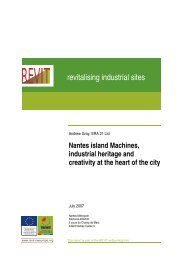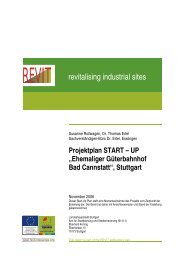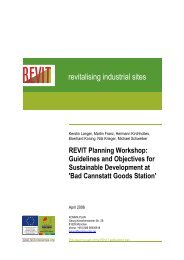REVIT Heritage Report.pdf
REVIT Heritage Report.pdf
REVIT Heritage Report.pdf
Create successful ePaper yourself
Turn your PDF publications into a flip-book with our unique Google optimized e-Paper software.
Torfaen County Borough Council<br />
<strong>REVIT</strong>: A Review of the Conservation of Industrial <strong>Heritage</strong> Assets on Brownfield Sites<br />
4.4.17 The site includes three former furnaces dating from 1930s and 60s and a<br />
number of steel gantries. Today, along with Guillouard building, the foundries<br />
and the reverbatory furnaces retain some of the few traces of industrial activity<br />
in this part of the island.<br />
4.4.18 Initially, the foundry had been proposed for demolition. However, the national<br />
heritage bureau, DRAC, recommended conserving and retaining the three<br />
furnaces and workshops. Proposals for the re-use of the structures have<br />
included converting it to a sheltered garden.<br />
4.4.19 The shipyards of the island with their rich industrial heritage will become public<br />
spaces along the Loire with tourist attractions, leisure uses and cultural<br />
functions. The aim is to regenerate and revitalise the historic shipyard area by<br />
developing new dwellings, offices and businesses with enhanced public<br />
spaces. The main elements of the industrial heritage will be conserved within<br />
the development of a new district with a capacity of 36,000 m 2 .<br />
4.4.20 The former Nantes shipyards covered three principal sites:<br />
• Les Ateliers et Chantiers de la Loire (ACL) (workshops and shipyards of<br />
the Loire) dating from 1881;<br />
• Les Chantiers Dubigeon (Dubigeon shipyard), dating from the 18 th century<br />
but primarily from 1914; and<br />
• Les Ateliers et Chantiers de Bretagne (ACB) (workshops and shipyards of<br />
Brittany) dating from 1895.<br />
4.4.21 The last ship was launched from the Nantes shipyards in 1986 and the<br />
workshops are now closed or converted to other uses. At the historic<br />
Dubigeon shipyard the three large industrial workshops and the Titan Crane,<br />
which dates from 1956, have been retained as a central part of the site.<br />
4.4.22 These spaces will be used for a range of temporary and permanent public<br />
cultural events with aim of increasing the number of visitors. Part of the<br />
Dubigeon site is used by the University of Nantes.<br />
4.4.23 The historic slipways were the main elements of the site used for boat building<br />
and consisted of:<br />
• Slipway No. 1 for submarines;<br />
• Slipway No. 2 for part of ACL 1914 to 1918 boats; and<br />
• Slipway No. 3 which will be restored and re-used.<br />
4.4.24 The area around the submarine slipways has been designated for shipbuilding<br />
and repair, in order to maintain the character and function of the site with<br />
submarine slipways used for public events.<br />
4.4.25 The surviving docks are used for the construction and restoration of small<br />
boats in order to retain the original use of the harbour. In addition, a further<br />
two further wet docks have been proposed, one on the east of the island and<br />
the other, directed towards the Atlantic, on the west.<br />
4.4.26 Other industrial features, like the quaysides, will be renewed and breakwaters<br />
around the area will be lowered to improve vistas. A series of pontoons with<br />
moorings will be established to revitalise the port function and use of the river.<br />
4.4.27 Work started in 2002 on the François-Mitterrand quay by providing a space for<br />
approximately 13,000 m 2 residential buildings with the establishment of the<br />
0014021/JM/001 31













